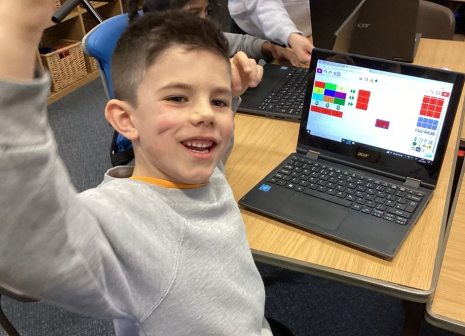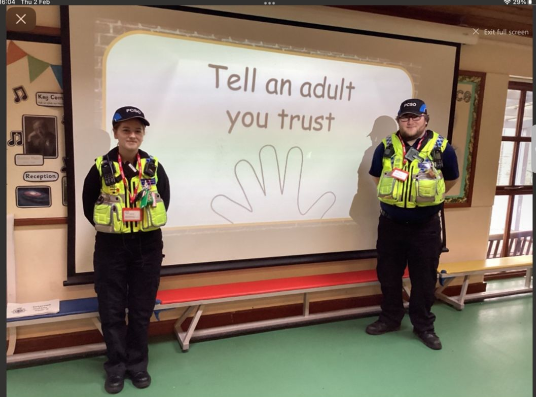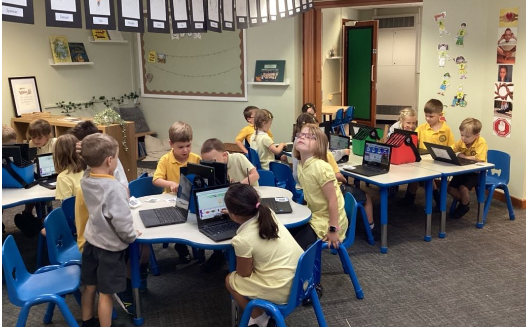Computing at CKIS
Our vision for Computing at CKIS
At CKIS we believe that every child should have the right to a curriculum that champions excellence; supporting pupils in achieving to the very best of their abilities. We understand the immense value technology plays not only in supporting the Computing and whole school curriculum but overall in the day-to-day life of our school.
We believe that technology can provide: enhanced collaborative learning opportunities; better engagement of pupils; easier access to rich content; support conceptual understanding of new concepts and can support the needs of all our pupils.

Purpose and aims of Computing (Intent statement)
Our curriculum provides a broad range of experiences for our pupils: Our pupils’ backgrounds, our culture and our climate for learning provide the following drivers that underpin ALL areas of our art curriculum:
- Learning to learn - which helps pupils to concentrate and focus and build resilience as learners
- Culture and Diversity - which helps pupils to develop enquiring minds about the wider world
- Environment and Community - which helps to instil in our pupils a respect for our environment and for our local and wider communities
–Creative arts and physical development - which helps our pupils to express themselves and excel as holistic learners
We provide an exciting, rich, relevant and challenging Computing curriculum for all pupils that will:
- Enthuse and equip children with the capability to use technology throughout their lives.
- Give children access to a variety of high quality hardware, software and unplugged resources.
- Instil critical thinking, reflective learning and a ‘can do’ attitude for all our pupils, particularly when engaging with technology and its associated resources.
- Teach pupils to become responsible, respectful and competent users of data, information and communication technology.
- Teach pupils to understand the importance of governance and legislation regarding how information is used, stored, created, retrieved, shared and manipulated.
- Equip pupils with skills, strategies and knowledge that will enable them to reap the benefits of the online world, whilst being able to minimise risk to themselves or others.
Pupils will use technology imaginatively and creatively to inspire and engage all pupils, as well as using it to be more efficient in the tasks associated with running an effective school.
Provide technology solutions for forging better home and school links.
Utilise computational thinking beyond the Computing curriculum.
Our curriculum exceeds the minimum government recommended/statutory guidance for programmes of study for Computing and other related legislative guidance (online safety).
We offer a thoughtful range of experiences that support our culture: pupils enjoy a ‘full spectrum’ of academic, physical, spiritual, moral, social, cultural activities that enrich their lives. We aim to ensure that all children have the confidence and skills to develop as resilient life-long learners.
Our curriculum has been developed over time through:
- Analysing the strengths and weakness of our previous curriculum
- Considering how the National Curriculum aims and the Early Years Goals are being met across the school
- Being active participants in the CLP Subject Leader Network meetings
- Accessing subject specific CPD and using this to inform our curriculum design
We aim for all pupils to:
- Gain an understanding of the art subject knowledge (see termly schemes of work) so that they develop conceptual understanding and the ability to recall and apply knowledge accurately
- Understand the subject specific vocabulary and use it independently within their learning
- Develop their artistic skills, such as sketching, colour mixing and printing, allowing them to use them independently in the provision (Challenge Time)
- Be inspired by a range of artists and begin to understand how to create work using their techniques and style
- Have the knowledge, skills and confidence to express their creativity
The teaching of Computing at CKIS (Implementation)
As a school, we have chosen the PurpleMash Scheme of Work from Reception to Year 2. The scheme of work is continued at CKJS and supports our teachers in delivering fun and engaging lessons which help to raise standards and allow all pupils to achieve to their full potential.
We are confident that the scheme of work more than adequately meets the national vision for Computing. It provides immense flexibility, strong cross-curricular links and integrates perfectly with the 2Simple Computing Assessment Tool. Furthermore, it gives excellent supporting material for less confident teachers.
Early Years
We aim to provide our pupils with a broad, play-based experience of Computing in a range of contexts. We believe the following:
- Early Years learning environments should feature ICT scenarios based on experience in the real world, such as in roleplay.
- Pupils gain confidence, control and language skills through opportunities to ‘paint’ on the interactive board/devices or control remotely operated toys.
- Outdoor exploration is an important aspect, supported by ICT toys such as metal detectors, controllable traffic lights and walkie-talkie sets.
- Recording devices can support children to develop their communication skills. This is especially useful for children who have English as an additional language.
Key Stage 1 outcomes
- Understand what algorithms are, how they are implemented as programs on digital devices, and that programs execute by following a sequence of instructions.
- Write and test simple programs.
- Organise, store, manipulate and retrieve data in a range of digital formats.
- Communicate safely and respectfully online, keeping personal information private, and recognise common uses of information technology beyond school

Demonstrating learning
In Computing, pupils demonstrate their learning in the following ways:
The pupils demonstrate their understanding through enrichment tasks in the continuous provision. These are observed and could be recorded using Seesaw, examples of children's work in their purple mash accounts and through cross curricular evidence.
Teachers carefully plan and monitor progress and adapt medium term plans to include key questions and checkpoints for children to demonstrate understanding in age-appropriate ways.
The children’s learning can be recorded on Seesaw and shared with parents. This gives families the opportunity to continue learning at home and further develop their knowledge and skills.

Meeting the needs of all pupils (inclusion)
Our school supports the principle that young children learn through play, and through well planned structured opportunities that are relevant, engaging and promote deep level thinking and learning.
Teaching through both a rich continuous provision, paired work, small group and whole class learning opportunities skilfully builds upon the experiences of the child and promotes their next steps as a learner.
Teachers and Teaching Partners competently provide a balance of structured cross curricula learning activities and child-initiated opportunities through high quality indoor and outdoor learning environments.
In this way we aim to ensure that children are actively involved in their learning and deepen their knowledge, skills and understanding becoming masters of their learning as:
• Problem solvers
• Resilient learners
• Collaborative thinkers
• Inspired questioners
All pupils are entitled to a broad and balanced curriculum that meets their needs.
Computing is taught in class groups, and accessible in our provision with all pupils included.
All our teachers know the pupils in their class and their differing needs well. They plan and adapt lessons to help all pupils know and remember more so they make very good progress.
Some pupils, including those with special educational needs or disabilities, or those with English an as additional language, may need extra support to access, understand and remember key concepts.
For these pupils, teachers use a range of effective strategies, whilst promoting independent learning as far as possible. These may include:
● adapting and scaffolding pupil activities and resources
● focussed additional support from an adult in class
● extra pre learning or overlearning of key knowledge before or after the lesson
Some pupils very quickly grasp the main concepts being taught and are able to think more deeply to extend their learning. To ensure they reach their full potential, teachers may:
● set more complex activities that require thinking at greater depth
● ask pupils to apply their knowledge to a different situation
● go further by asking them to explain their thinking to others
Assessment (Impact)
Pupil attainment is assessed using the 2Simple Computing Assessment Tool for Years 1 to 2. The tool enables staff to accurately identify the attainment of pupils through the detailed exemplification it has for each key learning intention.
Teachers keep accurate records of pupil attainment by entering data using the 2Simple Computing Assessment Tool.
Tracking of attainment by using the INSIGHT Assessment Tool is used to inform future planning.
Children are encouraged to self, peer and group assess work in a positive way using online collaborative tools such as 2Blog in Purple Mash.
Formative assessment is undertaken each session/interaction in Computing and pupils are very much encouraged to be involved in that process. Through using the progression of skills documents and displays from 2Simple, both teachers and pupils can evaluate progress. Features such as preview and correct in Purple Mash are used to further support feedback and assessment.
Summative assessment is undertaken in line with the assessment cycle (See Assessment Policy). Using electronic work samples from children’s portfolios on Purple Mash, teachers enter judgements about the samples into the 2Simple Computing Assessment Tool.
Work from a range of classes and abilities is shared using the Noticeboard feature in Purple Mash.
Resources
All resources are procured with the underlining considerations of value: The extent at which the resource impacts on learning and the material cost of this. Protocol details for procurement can be found in the school finance policy.
A range of resources is available which successfully supports delivering the Computing curriculum and enables all learners to reach their full potential.
Resources are suitably maintained and replenished when needed, which is overseen by the Computing Leader.
An itemised list of all resources is shared with staff and kept up to date by the Computing Leader.
Audits of school resources are conducted regularly by the Computing Leader, which informs bidding for budgets allocations.
The Computing Leader keeps up to date with the latest technology resources and will make informed decisions about possible procurement of them through their own research.
Suggestions for getting the very best out of the resources are made available to teaching and support staff by the Computing Leader.
The Computing Action Plan details foreseen future resource procurement which is shared with senior leaders before the budget setting period.
Monitoring and Evaluation
Monitoring standards of teaching and learning within Computing is the primary responsibility of the Computing Leader. All teachers are expected to keep an online portfolio or track children’s work using Purple Mash. This portfolio must contain work samples from all areas of the curriculum taught for the year group.
Details of monitoring and evaluation schedules can be found in the Computing Action Plan and School Monitoring Schedule.
The subject leader for computing monitors the quality of education regularly in accordance with the school’s monitoring timetable. This may take the form of:
● learning walks and drop ins, usually with a member of the senior leadership team, and sometimes with a governor.
● The subject leader looks at a range of online or other evidence across the school, sometimes with senior leaders or an adviser or governor.
● scrutiny of planning, particularly to evaluate coverage and progression within the curriculum as well as the extent to which planning is catering for the range of needs of pupils.
● pupil conferencing.
● surveys for pupils and/ or staff.
● lesson observations.
Subject leaders have regular support from the senior leadership team where aspects of the subject policy and action plan are monitored and discussed. Action plans are reviewed and shared with the staff three times a year to ensure all staff are aware of key actions.
Resulting actions may emerge with additional leadership support, resources or policy changes implemented.
Subject leaders routinely have a teacher appraisal objective linked to an aspect of their subject leadership. Following all these activities, strengths and areas for development are reported and discussed with staff. Resulting actions are recorded on the subject action plan and reported to governors.
The role of the governors
Every subject has a specific governor allocated to it. This governor evaluates the activities within this aspect and the impact on the quality of education and pupil outcomes.
